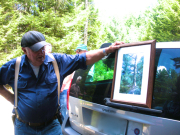
Study the two butterfly photographs to see if you can find any differences. One image shows a Monarch butterfly; the other is a Viceroy. Both are North American butterflies of the Nymphalidae family, both are orange and black with white spots, but two differences help in identifying them. Monarchs are slightly larger, with a wingspan ranging from 8.9 to 10.2 cm (3.5 to 4.125 inches), while Viceroys range between 5.3 and 8.1 cm (2.125 to 3.25 inches).
Of course, this size difference is not very helpful if you are looking at one individual. A second difference makes the identification immediate. The Viceroy has a black line that runs across the veins on its hindwing. Now, look at the photographs again and see if you can tell which is which.

Viceroys and Monarchs exhibit a concept in biology known as mimicry, in which one species adopts the appearance of another as a protection against predators. Monarchs lay their eggs on milkweed plants, which are toxic to many animals, but not to the Monarch caterpillars. The caterpillars feed on milkweed until they pupate; as a result, adult Monarchs are distasteful due to the milkweed toxins they have ingested. After just one taste, birds know to avoid orange and black butterflies with white spots.
In 1958, zoologist Jane Van Zandt Brower designed an experiment to compare the palatability of Viceroys and Monarchs in the Florida Scrub Jay. When captive birds were fed Monarchs, they quickly discovered this butterfly’s horrible taste and learned to avoid it. Later, when the same birds were offered Monarchs and similar-looking Viceroys, they avoided both species.
Brower concluded that the Viceroy uses a strategy known as Batesian mimicry, in which one innocuous species takes on the appearance of a harmful species to enjoy the protection of avoidance by predators.
That same 1958 study revealed another finding. Although the Viceroy was more palatable than the Monarch, it was still less palatable compared with non-mimetic species. In their caterpillar stage, some viceroys feed on leaves of poplars and willows, ingesting noxious chemicals that deter herbivores. (One of those chemicals is salicylic acid, a bitter compound found in aspirin.)
Maybe Viceroys are not so harmless, and the mimicry is not Batesian, but Müllerian. This is the name given to mimicry when both species are harmful to predators. Scientists now believe that the distinction between the two forms of mimicry is not absolute, and the relationship between Monarchs and Viceroys is somewhere along a spectrum between the two forms.
Fenvale Rookery

On August 8, 22 of us enjoyed a walk around the heron rookery at Fenvale, in Andover, as part of the Andover Institute’s initiative “Space Explorations.” Although the great blue herons have raised their young by now, we observed their nests on snags and were watching when one heron landed on the shore of the beaver pond.
Highlights of the walk were remarks by Paul Fenton and wildflower observations by the Schwartz family. Paul grew up on the farm at Fenvale and shared stories with us — as only Paul can! — about the property. When the family stopped farming, Paul subdivided the property into large house sites, while protecting the Blackwater River corridor, the beaver ponds, and surrounding woods with a conservation easement. Thanks to the Fentons, we are all welcome to walk through and enjoy this beautiful place.
We were fortunate that Jonathan, Janet, and Rebecca Schwartz joined us for the walk, since they know their wildflowers. Less than a minute into the walk, Jonathan noticed a Checkered Rattlesnake Plantain blooming along the side of the path. A relative of the more common Downy Rattlesnake Plantain, this rarer species features exquisite orchid-shaped white flowers.
Thanks to the Schwartzes, I now recognize the difference between Indian Pipe and Pinesap. Rebecca was first to point out a large colony of Pinesap, under a pine tree, naturally. It lacks chlorophyll so it isn’t green, like Indian Pipe, and depends on the roots of the pine for nutrients.
The other wildflower treat was a large patch of beautiful white dewdrops, or false-violets. The Schwartz family has been spending their summers on Bradley Lake for 25 years. Jonathan reports seeing a cormorant on Bradley this summer, the first sighting in over a decade.
Please send your observations, questions, and photos to AndoverNaturally@nullgmail.com.